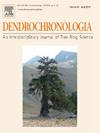Long-term tree growth-climate relationships of Fagus orientalis Lipsky at high-elevation forest edges in the Alborz Mountains, northern Iran
IF 2.7
3区 农林科学
Q1 FORESTRY
引用次数: 0
Abstract
Rapid warming at high elevations may increase the sensitivity of tree growth to climatic signals. While several studies have examined tree growth in the Hyrcanian forests of the Alborz Mountains (Iran), the impact of climatic factors on Fagus orientalis Lipsky at its upper growth limit remains unclear. This study investigates the relationship between the annual tree-ring width of Fagus orientalis and climate over more than a century at its elevational growth limit. We constructed two tree-ring width chronologies from cores collected at elevations of 2400–2550 m a.s.l. at two contrasting sites in the Hyrcanian Forest, which differ in soil physical conditions. We correlated the tree-ring data with monthly mean temperature, precipitation sums, and the six-month standardized precipitation-evapotranspiration index. Our results show that moisture deficit, particularly during the growing season (June to November), is a critical factor affecting growth. Precipitation has a more pronounced influence on growth at high elevations compared to lower elevations in the Hyrcanian Forests, suggesting that Fagus orientalis is more dependent on precipitation and soil moisture during summer and autumn drought stress. The distance from the Caspian Sea and the constellation of local climatic factors such as low precipitation and high irradiation are likely to contribute to reduced moisture availability at higher elevations. Divergent results from contrasting sites highlight the important role of soil physical conditions in shaping growth-climate relationships. This study provides valuable insights into the radial growth-climate relationships of Fagus orientalis at elevated sites, and enhances our understanding of the sensitivity of the species in response to future climate change.
伊朗北部阿尔博尔斯山脉高海拔森林边缘地区东方Fagus orientalis Lipsky树木生长与气候的长期关系
高海拔地区的快速变暖可能会增加树木生长对气候信号的敏感性。虽然有几项研究调查了伊朗阿尔博尔斯山脉海尔卡尼亚森林的树木生长情况,但气候因素对东方Fagus orientalis Lipsky生长上限的影响尚不清楚。本文研究了一个多世纪以来东方木海拔生长极限的年轮宽度与气候的关系。我们从海拔2400-2550 m a.s.l.两个不同土壤物理条件的海卡尼亚森林不同地点采集的岩心中构建了两个树轮宽度年表。我们将树木年轮数据与月平均气温、降水总量和6个月标准化降水-蒸散指数进行了关联。我们的研究结果表明,水分亏缺,特别是在生长季节(6月至11月),是影响生长的关键因素。降水对海卡尼亚森林生长的影响在高海拔地区比在低海拔地区更为明显,这表明在夏秋干旱胁迫下,东方Fagus对降水和土壤水分的依赖性更强。距离里海的距离和当地气候因素的组合,如降水少和辐射高,可能会导致高海拔地区水分供应减少。来自不同地点的不同结果强调了土壤物理条件在形成生长-气候关系中的重要作用。本研究为高纬度地区东方Fagus的径向生长-气候关系提供了有价值的见解,并增强了我们对该物种对未来气候变化的敏感性的理解。
本文章由计算机程序翻译,如有差异,请以英文原文为准。
求助全文
约1分钟内获得全文
求助全文
来源期刊

Dendrochronologia
FORESTRY-GEOGRAPHY, PHYSICAL
CiteScore
5.50
自引率
13.30%
发文量
82
审稿时长
22.8 weeks
期刊介绍:
Dendrochronologia is a peer-reviewed international scholarly journal that presents high-quality research related to growth rings of woody plants, i.e., trees and shrubs, and the application of tree-ring studies.
The areas covered by the journal include, but are not limited to:
Archaeology
Botany
Climatology
Ecology
Forestry
Geology
Hydrology
Original research articles, reviews, communications, technical notes and personal notes are considered for publication.
 求助内容:
求助内容: 应助结果提醒方式:
应助结果提醒方式:


